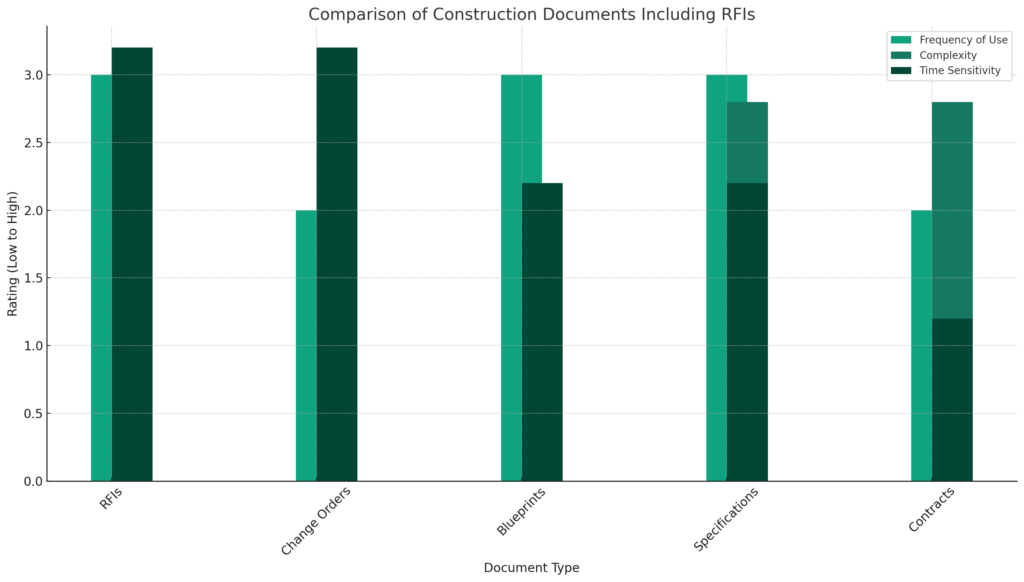In the dynamic world of construction, effective communication is pivotal for the seamless execution of any project. Among the myriad of tools designed to foster clear and precise communication, the Request for Information (RFI) stands out as a critical component in the construction industry’s arsenal. As we step into 2024, understanding the nuances of RFIs has become more important than ever. This article aims to demystify RFIs in construction, providing you with a comprehensive understanding of their purpose, process, and significance.
| Document Type | Purpose | Content |
|---|---|---|
| RFIs | Seek clarification on project details | – Questions regarding plans, specifications, or contract terms; Requests for missing information; Concerns about inconsistencies or conflicts; Documentation of formal inquiries; Responses from the project team |
| Construction Drawings | Blueprint for construction | – Architectural plans; Structural details; Mechanical, electrical, plumbing (MEP) plans; Site plans; Details of materials and finishes |
| Specifications | Detailed instructions for construction | – Materials and methods specifications; Quality standards; Installation requirements; Performance criteria |
| Contracts | Legal agreements between parties | – Scope of work; Payment terms and schedules; Responsibilities of each party; Dispute resolution mechanisms |
| Change Orders | Document changes to the original contract | – Description of changes; Cost implications; Schedule adjustments; Approval signatures |
| Submittals | Approval process for materials and products | – Product data; Samples; Shop drawings; Certificates |
| Punch Lists | Identify incomplete or defective work | – List of items requiring correction; Location within the project; Deadline for completion |
So what are RFIs in construction? An RFI in construction is a formal document used to request additional information or clarification regarding the plans, drawings, specifications, or contracts of a project. RFIs are typically submitted by contractors, subcontractors, or other stakeholders to the project’s designers, architects, or owners. The primary goal of an RFI is to resolve uncertainties, fill in gaps in information, and ensure that everyone involved has a clear understanding of the project requirements.
RFIs play a pivotal role in mitigating misunderstandings and preventing potential project delays and cost overruns. They serve as a documented trail of questions and answers, providing clarity and preventing disputes over what was communicated and agreed upon. In a fast-paced construction environment, where decisions and modifications can have significant time and financial implications, the importance of RFIs cannot be overstated.
Start
Receive RFI from project team
Review RFI content
Determine RFI complexity and urgency
Assign RFI to appropriate party (if not already)
Assign RFI to relevant stakeholders
Investigate RFI content
Review project documentation and conduct necessary investigations, if any
Provide response to RFI originator
Review response internally
Finalize response and obtain necessary approvals
Transmit response to RFI originator and other relevant project stakeholders
End
The RFI process is straightforward yet requires meticulous attention to detail to ensure its effectiveness. It typically involves the following steps:
While RFIs are indispensable, they are not without challenges. Excessive RFIs can indicate poor project planning or design issues, potentially leading to delays. To mitigate such risks, it is crucial to adhere to best practices, such as:

Creating effective RFIs in construction requires clear communication, attention to detail, and an understanding of the project requirements. Here are some resources that could be incredibly useful in creating RFIs:
These resources emphasize the critical role of RFIs in construction projects, guiding professionals on how to manage them effectively to avoid delays, minimize costs, and ensure the success of the project.
As the construction industry continues to evolve, so does the approach to managing RFIs. With advancements in digital tools and software, the process of submitting, tracking, and responding to RFIs is becoming more streamlined and efficient. Embracing these technological solutions can significantly reduce the time and resources spent on RFIs, allowing for more focus on the actual construction work.
In conclusion, RFIs are a vital component of the construction industry, ensuring that projects are executed as planned, with minimal surprises. By understanding and effectively managing RFIs, construction professionals can significantly enhance project outcomes, ensuring on-time and within-budget delivery. As we navigate through 2024, the role of RFIs in facilitating clear communication and project success continues to be paramount.
ConstructionCompanies.com offers a comprehensive platform for users to effortlessly search and find construction companies across various categories and states throughout the Unite States. ConstructionCompanies.com also offers insights and tips to help users make informed decisions when selecting a construction partner.